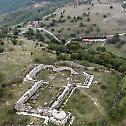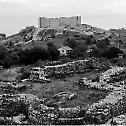Communique of the Raška-Prizren Diocese concerning the unauthorized construction work at the Cathedral Church of St. Nicholas in Novo Brdo
With great concern, the Diocese of Raška-Prizren has received information about an announcement specifying the beginning of construction work on the site of an old Serbian medieval church, that of St. Nicholas, which was the cathedral church for the Serbian Orthodox bishops of Novo Brdo and Gračanica, and which is located near the Novo Brdo fortress. https://en.wikipedia.org/wiki/Novo_Brdo_Fortress
The church was built in the middle of the 14th century and was enlarged during the reign of Despot Stephan Lazarević after 1455. According to all evidence available, it was later turned into a mosque during the Ottoman period, and then was later destroyed by an earthquake and remained in ruins up to the present day, like the other remains of the town surrounding it, which was quickly abandoned. Similar to the other churches and monasteries built by the Nemanjić dynasty in the 13th and 14th centuries such as Sopoćani, Arilje, and Visoki Dečani, the Novo Brdo Church of St. Nicholas was constructed in the style of a romanesque basilica, and until the fall of Novo Brdo to the Ottoman rule, it was the main center of Orthodox worship for the region. Not far from this church, we also find the remains of the city’s Roman Catholic Church which is known as the Saxon Church, thus named for the Saxon miners who, together with merchants from Dubrovnik and the local Serbian population, comprised a part of the rich and multifaceted ethnic and religious mosaic of medieval Novo Brdo, one of the most important cities of medieval Serbia.
Information about the planned project to conserve the church of St. Nicholas appeared in the Kosovo media and according to the information available, the project is being led by the Archeological Institute of Kosovo with the financial backing of the German Embassy in Priština (https://kallxo.com/inagurohet-restaurimi-i-katedrales-se-artanes/ и https://www.koha.net/kulture/165323/restaurohet-katedralja-mesjetare-e-novoberdes/). In total disregard for Kosovo’s law on official languages and on the names of municipalities, the media is reporting on “the Cathedral in Artana, formerly Novo Brdo,” thus ignoring the official name of the municipality.

The Diocese of Raška-Prizren would like to remind everyone involved that the Church of St. Nicholas is located in one of about 40 special protective zones, which according to the laws of Kosovo, requires a special procedure to do any work there. This special procedure of determining if work can be carried out on a site depends not only on the decisions of Kosovo institutions, but also the position of the Serbian Orthodox Church. Even apart from this, this old religious edifice is incorrectly described on the website of the Kosovo Ministry of Culture as being a Roman Catholic Church, without any references given to the actual history of the church and the archeological research which has been done on it up until now (https://dtk.rks-gov.net/tkk_objekti_sr.aspx?id=283) which is yet another sad example of this region’s tendency to alter historical facts. The Diocese has already contacted the German Embassy with regard to these discrepancies, and furthermore, it plans to urgently get the Commission for Special Protective Zones involved, of which the Diocese of Raška-Prizren is a member. In cooperation with the OESC and the EU Office, it is of great importance that all of the facts be properly established and that this restoration project concerning the ruins of the Church be brought back into compliance with the law. Failing this, any further steps taken on this project on this location would be illegal.
The Church of St. Nicholas was excavated in the 1950s and 1960s, and during these excavations, numerous inscriptions and stone figures were found which clearly demonstrate the origins of the Church and its style. A number of tombs were also found on the site of the Church, which have since been opened and the bones removed to Priština without the prior knowledge of the Serbian Orthodox Church. The Diocese’s firm position is that any kind of conservation works on the site, along with the manner in which this piece of cultural heritage is presented, can be done only by taking into account the archeological work which has been already done, and in full cooperation with respected Serbian experts whom the Diocese will employ. Any kind of politicization of cultural heritage, especially a one-sided altering of historical facts, is completely unacceptable and counterproductive.
All of the research done on St. Nicholas Church and its history is presented in detail in the book, “The Church of St. Nicholas—the Cathedral of Novo Brdo” by archeologists Mark Popović and Igor Bjelić, published in Serbian and in English in Belgrade in 2018. On the basis of the massive amount of historical and archeological sources cited, photographs of the location, excavated artifacts, drawings, and possible ideal reconstructions of the church, we can get, for now, the most complete picture of Novo Brdo’s Cathedral Church.
This useful book in English/Serbian i available in PDF format here: https://d.pr/free/f/34iYBL
Issued at the Office of the Diocese of Raška-Prizren
Prizren-Gračanica, June 6, 2019





